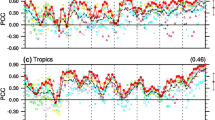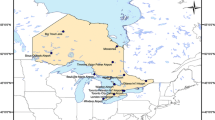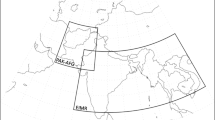Abstract
Weather forecasting is based on the use of numerical weather prediction (NWP) models that are able to perform the necessary calculations that describe/predict the major atmospheric processes. One common problem in weather forecasting derives from the uncertainty related to the chaotic behaviour of the atmosphere. A solution to that problem is to perform in addition to “deterministic” forecasts, “stochastic” forecasts that provide an estimate of the prediction skill. A computationally feasible approach towards this aim is to perform “ensemble forecasts”. Indeed, in the frame of SEE-GRID-SCI EU funded project a Regional scale Multi-model, Multi-analysis ensemble forecasting system (REFS) was built and ported on the Grid infrastructure. REFS is based on the use of four limited area models (namely BOLAM, MM5, ETA, and NMM) that are run using a multitude of initial and boundary conditions over the Mediterranean. This paper presents the tools and procedures followed for developing this application at a production level.




Similar content being viewed by others
References
Akylas E, Kotroni V, Lagouvardos K (2007) Sensitivity of high resolution operational weather forecasts to the choice of the planetary boundary layer scheme. Atmos Res 84:49–57
Altshuler E, Fennessy M, Shukla J, Juang H, Rogers E, Mitchell K, Kanamitsu M (2002) Seasonal simulations over North America with a GCM and three regional models. COLA Tech Rpt 115:66
Arakawa A, Lamb VR (1977) Computational design of the basic dynamical process of the UCLA general circulation model. Methods in Computational Physics, 17, Academic Press, pp 173–265
Betts AK, Miller MJ (1986) A new convective adjustment scheme. Part II: single column tests using GATE wave, BOMEX and arctic air-mass data sets. Quart J Roy Meteor Soc 112:693–709
Black TL (1994) The new NMC mesoscale Eta Model: description and forecast examples. Weather Forecast 9:265–278
Buzzi A, Foschini L (2000) Mesoscale meteorological features associated with heavy precipitation in the southern Alpine region. Meteorol Atmos Phys 72:131–146
Buzzi A, Fantini M, Malguzzi P, Nerozzi F (1994) Validation of a limited area model in cases of Mediterranean cyclogenesis: surface fields and precipitation scores. Meteorol Atmos Phys 53:137–153
Charney J (1951) Dynamical forecasting by numerical process. Compedium of meteorology. Americal Meteorological Society, Boston
Chen F, Janjic Z, Mitchell K (1997) Impact of atmospheric surface-layer parameterizations in the new land-surface scheme of the NCEP mesoscale Eta Model. Bound-Layer Meteor 85:391–421
Chou SC, Bustamante JF, Gomes JL (2005) Evaluation of seasonal precipitation forecasts over South America using Eta model. Nonlin Proc Geophys 12:537–555
Dudhia J (1993) A non-hydrostatic version of the Penn State/NCAR nesoscale model: validation tests and simulation of an Atlantic cyclone and cold front. Mon Wea Rev 121:1493–1513
Fels SB, Schwarzkopf MD (1975) The simplified exchange approximation: a new method for radiative transfer calculations. J Atmos Sci 32:1475–1488
Ferrier BS, Jin Y, Lin Y, Black T, Rogers E, DiMego G (2002) Implementation of a new grid-scale cloud and precipitation scheme in the NCEP Eta Model. 19th Conf. on Weather Analysis and Forecasting/15th Conf. on Numerical Weather Prediction, San Antonio, TX, Amer. Meteor. Soc., pp 280–283
Foster I, Kesselman C (2003) The grid: blueprint for a new computing infrastructure, 2nd edn. Morgan Kaufman, San Francisco
Hong S-Y, Pan H-L (1996) Nonlocal boundary layer vertical diffusion in a medium-range forecast model. Mon Wea Rev 124:2322–2339
Janjic ZI (1979) Forward-backward scheme modified to prevent two-grid-interval noise and its application in sigma coordinate models. Contrib Atmos Phys 52:69–84
Janjic ZI (1984) Nonlinear advection schemes and energy cascade on semi-staggered grids. Mon Wea Rev 112:1234–1245
Janjic ZI (1990) The step-mountain coordinate: physical package. Mon Wea Rev 118:1429–1443
Janjic ZI (1994) The step-mountain eta coordinate model: further developments of the convection, viscous sublayer, and turbulence closure schemes. Mon Wea Rev 122:927–945
Janjic ZI (2003) A nonhydrostatic model based on a new approach. Meteorol Atmos Phys 82:271–285
Janjic ZI, Gerrity JP Jr, Nickovic S (2001) An alternative approach to nonhydrostatic modeling. Mon Wea Rev 129:1164–1178
Kain JS, Fritsch JM (1993) Convective parameterization for mesoscale models: The Kain-Fritsch scheme. The Representation of Cumulus in numerical models, Meteor. Monogr., No 46, Amer. Met., Soc., pp 165–177
Katsafados P, Papadopoulos A, Kallos G (2005) Regional atmospheric response to tropical Pacific SST perturbations. Geophys Res Lett 32:L04806. doi:10.1029/2004GL021828
Kotroni V, Lagouvardos K (2001) Precipitation forecast skill of different convective parameterization and microphysical schemes: application for the cold season over Greece. Geoph Res Let 108(10):1977–1980
Kotroni V, Lagouvardos K (2004) Evaluation of MM5 high-resolution real-time forecasts over the urban area of Athens, Greece. J Appl Meteor 43:1666–1678
Lacis AA, Hansen JE (1974) A parameterization of the absorption of solar radiation in the earth's atmosphere. J Atmos Sci 31:118–133
Lagouvardos K, Kotroni V, Dobricic S, Nickovic S, Kallos G (1996) On the storm of 21-22 October 1994 over Greece: observations and model results. J Geophys Res 101(D21):26217–26226
Lagouvardos K, Kotroni V, Nickovic S, Jovic D, Kallos G (1999) Observations and model simulations of a winter sub-synoptic vortex over the Central Mediterranean. Meteorol Appl 6:371–383
Lagouvardos K, Kotroni V, Koussis A, Feidas C, Buzzi Α, Malguzzi P (2003) The meteorological model BOLAM at the National Observatory of Athens: assessment of two-year operational use. J Appl Meteor 42:1667–1678
Lagouvardos K, Floros E, Kotroni V (2010) A grid-enabled regional-scale ensemble forecasting system in the Mediterranean. J Grid Computing 8:181–197
Lorenz EN (1965) A study of the predictability of a 28-variable atmospheric model. Tellus 17:321–333
Lorenz EN (1968) The predictability of a flow which possesses many scales of motion. Tellus 21:289–307
Louis JF (1979) A parametric model of vertical eddy fluxes in the atmosphere. Boundary Layer Met 17:187–202
Louis JF, Tiedtke M, Geleyn JF (1982) A short history of the PBL parameterization at ECMWF. Proceedings of ECMWF workshop on PBL parameterization. Reading 25–27 Nov. 81, pp 59–80
Mesinger F (1974) An economical explicit scheme which inherently prevents the false two-grid-interval wave in the forecast fields. Proc. Symp. “Difference and Spectral Methods for Atmosphere and Ocean Dynamics Problems”, Academy of Sciences, Novosibirsk 1973; Part II, pp 18–34
Mesinger F (1977) Forward-backward scheme, and its use in a limited area model. Contrib Atmos Phys 50:200–210
Mesinger F (1984) A blocking technique for representation of mountains in atmospheric models. Riv Meteor Aeronautica 44:195–202
Mesinger F (2000) Numerical methods: the Arakawa approach, horizontal grid, global, and limited-area modeling. General circulation model development: past, present and future. International Geophysics Series, Vol. 70, D. A. Randall, Ed., Academic Press, pp 373–419
Mesinger F, Janjic ZI (1974) Noise due to time-dependent boundary conditions in limited area models. The GARP Programme on Numerical Experimentation, Rep. No. 4, WMO, Geneva, pp 31-32
Mesinger F, Lobocki L (1991) Sensitivity to the parameterization of surface fluxes in NMC’s eta model. 9th Conf. on Numerical Weather Prediction, Denver, CO, Amer. Meteor. Soc., pp 213–216
Mesinger F, Jovic D (2004) Vertical coordinate, QPF, and resolution. The 2004 Workshop on the Solution of Partial Differential Equations on the Sphere, Frontier Res. Center for Global Change (FRCGC), Yokohama, Japan, 20–23 July 2004. ppt in CD-ROM, Vol. 2
Mesinger F, Janjic ZI, Nickovic S, Gavrilov D, Deaven DG (1988) The step-mountain coordinate: model description and performance for cases of Alpine lee cyclogenesis and for a case of an Appalachian redevelopment. Mon Wea Rev 116:1493–1518
Mościcki JT, et al. (2009) Ganga: a tool for computational-task management and easy access to Grid resources. Computer Physics Communications, abs/0902.2685
Palmer TN, Molteni F, Mureau R, Buizza R, Chapelet P, Tribbia J (1993) Ensemble prediction. Proceedings of the ECMWF Seminar on Validation of models over Europe: vol. I, ECMWF, Shinfield Park, Reading, RG2 9AX, UK
Schultz P (1995) An explicit cloud physics parameterization for operational numerical weather prediction. Mon Wea Rev 123:3331–3343
Spencer PL, Stensrud DJ (1998) Flash flood events: importance of the subgrid representation of convection. Mon Wea Rev 126:2884–2912
Tracton MS, Kalnay E (1993) Ensemble forecasting at NMC: practical aspects. Weather Forecast 8:379–398
Wei M, Toth Z, Wobus R, Zhu Y (2008) Initial perturbations based on the ensemble transform (ET) technique in the NCEP global operational forecast system. Tellus 60A:62–79
Acknowledgments
This work has been supported by the EU funded project SEE-GRID-SCI. The authors are also grateful to NCEP (USA) for providing GFS initial and forecast field data that allowed the operational use of the regional ensemble forecasting system.
Author information
Authors and Affiliations
Corresponding author
Additional information
Communicated by: Emanouil Atanassov
Rights and permissions
About this article
Cite this article
Kotroni, V., Floros, E., Lagouvardos, K. et al. Multi-model multi-analysis ensemble weather forecasting on the grid for the South Eastern Mediterranean Region. Earth Sci Inform 3, 209–218 (2010). https://doi.org/10.1007/s12145-010-0071-2
Received:
Accepted:
Published:
Issue Date:
DOI: https://doi.org/10.1007/s12145-010-0071-2




